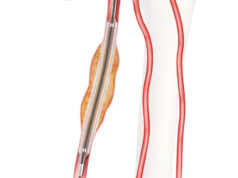
An interim analysis from the DISRUPT PAD III observational study showed that intravascular lithotripsy (IVL; Shockwave Medical) performs “consistently well” across challenging peripheral vessels, lesions and subgroups of patients, Ehrin J Armstrong, medical director at Adventist Heart and Vascular Institute in St Helena, USA, told a clinical trials late-breaking session at Vascular Interventional Advances (VIVA) 2021 (5–7 October, Las Vegas, USA).
Analysis of the full data set contained in the study—reputedly the largest angiographic core lab adjudicated real-world evidence for IVL in heavily calcified peripheral arteries according to Shockwave Medical—is due to be presented next year.
Findings from the first 752 patients included in the interim analysis demonstrated that IVL “consistently” showed its ability to safely and effectively modify superficial and deep calcium across multiple vascular beds, lesion types and in patients with chronic limb-threatening ischaemia (CLTI), Armstrong reported. IVL resulted in consistent reduction in the diameter of stenosis with no associated distal embolisation, abrupt closure or thrombotic events at any time, according to Shockwave. IVL outcomes were comparable to the previously reported DISRUPT PAD III randomised controlled trial (RCT) outcomes showing minimal procedural complications and consistent reduction in diameter stenosis. The technology was also successfully used in combination with adjunctive technologies, including specialty balloons and atherectomy, in the treatment of complex calcified lesions, the company further reported.
“Patients with heavy calcification have traditionally been excluded from endovascular treatment trials resulting in little available evidence to provide guidance for treating this challenging patient population,” said Armstrong. “The DISRUPT PAD III [observational study] shows that in common clinical situations that physicians encounter daily, peripheral IVL performs consistently well in a variety of peripheral vessels, lesions and subgroups.”
The observational portion of DISRUPT PAD III is a prospective, multicentre, single-blind study of real-world patients, which augments the DISRUPT PAD III RCT. The interim analysis involves patients enrolled between November 2017 and June 2019 at 18 global sites.
Of the 852 lesions treated in the iliac, common femoral, superficial femoral, popliteal and infrapopliteal arteries, 88% presented with moderate/severe calcification, with an average calcified length of 127mm. The use of IVL in these lesions resulted in a final residual stenosis of 24%, similar to the DISRUPT PAD III RCT finding of 22%, Armstrong told VIVA attendees. Patients also experienced minimal procedural complications, with only 0.9% and 0.1% of patients experiencing final dissections and perforations, respectively. “Notably, there were no instances of embolisation, thrombus, no reflow or abrupt closure.” The observational study completed enrolment in June 2021 with a total of 1,373 patients.
Late-breaking session panellist Benjamin W Starnes, the chief of Vascular Surgery at the University of Washington (UW) in Seattle, USA, commented: “Your one-year follow-up data happened right in the middle of a pandemic—what was it like to conduct a clinical trial in the setting of a pandemic?”
Armstrong said the dynamic of the COVID-19 virus was initially challenging, explaining: “At our own hospital, it was mandated that the research coordinators not interact with patients for the first few months, so I conducted a lot of the follow-up myself. That being said, our patients with peripheral arterial disease [PAD]—because they have such complex issues—in some cases we flexed to doing virtual visits, but we were able to get these patients in in most cases with outstanding follow-up. Which, to me, really demonstrated the versatility of conducting research, despite dealing with all these different complexities in the setting of a pandemic.”










